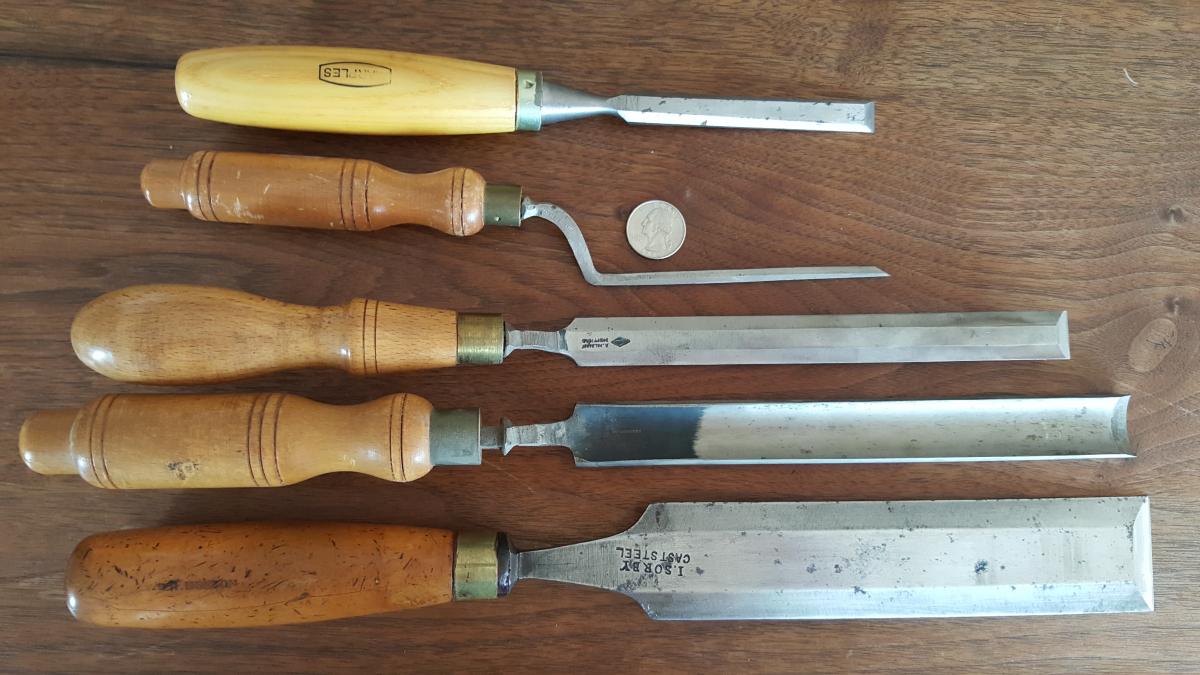
In the days before CNC, patternmakers would carve precise patterns used for metal casting. Pattern makers faced many challenges in their work: the objects for which they made patterns ranged from tiny to huge; the need for specific dimension; and, because of the nature of casting, how rare it was that they dealt with square simple surfaces.
Pattern makers consequently had specific edge tools for their craft. Here are several of them.
From the top of the picture:
A classic English bench chisel, in this case by Marples. English bench chisels are typically longer than American socketed chisels such as the Stanley 750 (which, come to think of it, I should have included in the picture. Sorry.) I included this chisel in the picture to give you a sense of how long all the other chisels are. The Stanley 720, which is typical of American paring chisels, is pretty short compared to these English chisels.
A narrow 1/8" cranked paring chisel by A. Hildick (Sheffield). I am not sure if it is full length. (See below on cranked chisels.)
A wider cranked paring chisel by the same maker, probably never used. The photo doesn't really show the crank, but it's the same as the 1/8" only larger all around.
An in-cannel scribing gouge - English, but maker unknown (I can't read the stamp). The handle is incorrectly installed and the inside of the gouge isn't ground bright. Not grinding the inside of a gouge was pretty common, but that handle wasn't put on by a cutler. Probably the chisel was bought unhandled and handled by the user.
Finally a nice wide, long, but not new, English pattermaker's paring chisel.
With the exception of the bench chisel, all of these tools were meant to be pushed by hand and never malleted. They were also sharpened at very, very low angles. 20 degrees with a tiny micro-bevel was pretty common. Of course this leaves a fairly fragile edge, but one that takes very little effort to pare with a lot of control. And control is the reason the chisels are so long. With patternmaking, it is pretty common to need to shave off a sliver to a dimension, and the further away you are from the cut - that is, the longer the handle or blade - the fewer errors any hand motion will introduce. Japanese paring chisels typically have a short blade but a long wooden handle, which accomplishes more of the same thing.
English paring chisels were offered in sizes ranging from 1/8" - 2" and specifically identified in catalogs as "Beveled Edge Long Thin Paring Chisels." Unbeveled ones were less expensive but also available. The "long and thin" part of the description wasn't a random happenstance or an accident. They were made specifically to capitalize on these features. A long and thin steel blade has a touch of flexibility in use, giving better feedback and greater control. You can also "English" the cut with a little pressure that just doesn't work with thicker tools. The flexibility is an advantage over Japanese paring chisels.
The downside is that long, thin paring chisels were hellish to make. Between forging, and grinding, and hardening, the chisels would warp. Skilled smiths and grinders knew how to compensate for the distortion, however, so when all said and done you ended up with a straight tool.
Nicely ground, long paring chisels that are thin with wide bevels are no longer made. My harlequin set by various members of the Sorby family doesn't see much use in regular cabinetry, although they are the cat's pajamas in paring a mortise to a scribe line after chopping. I have never seen a 1/8" straight paring chisel in the flesh. They were made, but are not common at all. Wider sizes are very nice to have if you can find them in good shape (no pitting) and near original length.
I have two sets of cranked paring chisels: the rest of this set by Hildick, and an American set by Buck. The English set is longer, and has better forgings. The reason they exist is that in pattermaking it isn't uncommon to have to level a pattern detail from far from the edge, where a regular chisel cannot reach. They do not have much application in modern cabinetry and I don't think I have ever used mine.
Gouges, of course, are pretty useful in woodworking. This particular gouge is in-cannel, meaning the bevel is on the inside, unlike a regular carving tool sharpened on the outside (out-cannel). Having the cutting edge on the outside edge of the gouges means you can easily cut an exact concave arc in wood, which is handy for setting wooden hinges and certain other woodworking details. These, however, are "scribing gouges," which means that the gouge curve is in the precise arcs of a circle, unlike most gouges (in- and out-cannel) that follow a carving sweep chart . Scribing gouges are essential for precise patternmaking to a print, and a century ago you could order them in any number of sizes. They are no longer made.
|
 Joel's Blog
Joel's Blog Built-It Blog
Built-It Blog Video Roundup
Video Roundup Classes & Events
Classes & Events Work Magazine
Work Magazine























I think Sorby and Henry Taylor make what they call "paring chisels" neither has a wide bevels of the older tools. But outside observation I have no option, I just don't know.
Ray Iles has threatened to make them for several years. He knows how - but it's a big undertaking and he is swamped with work.